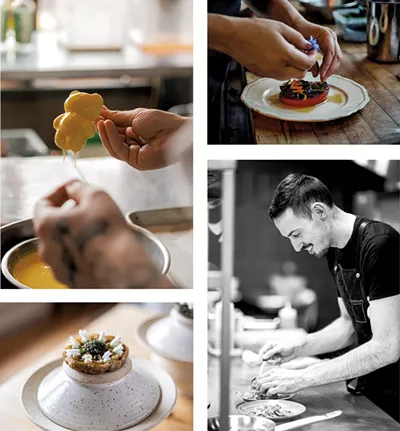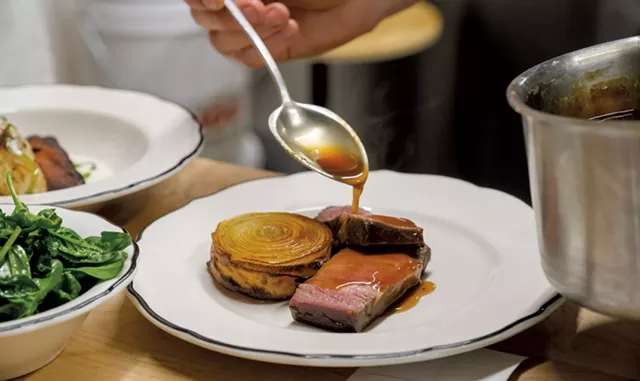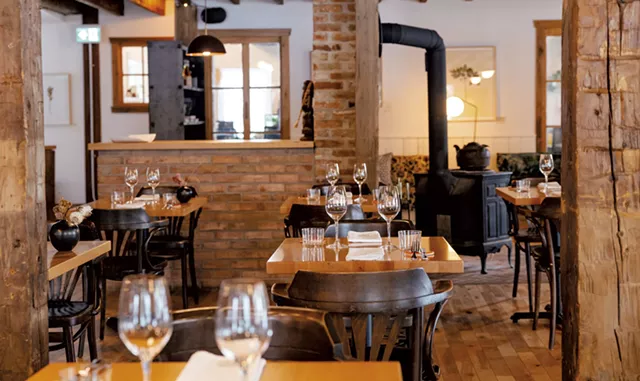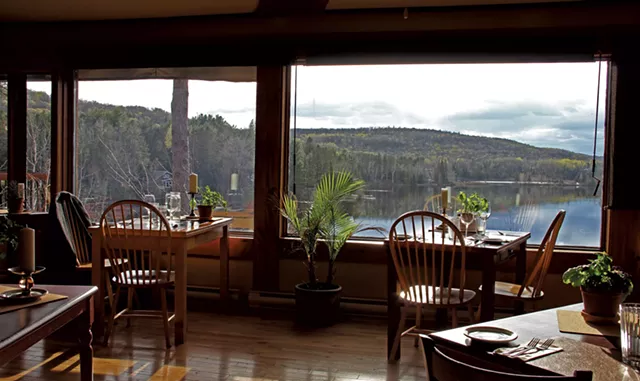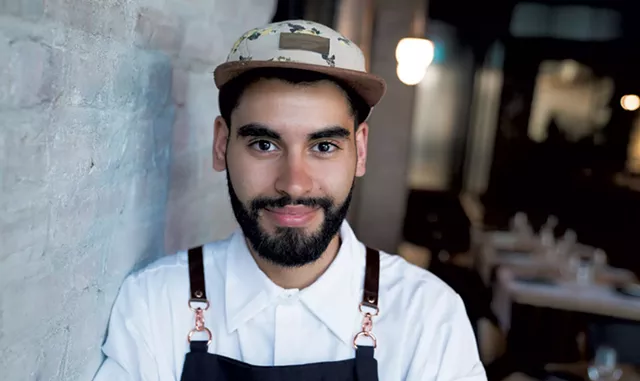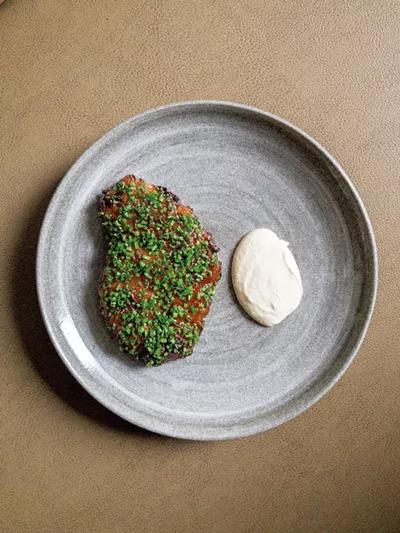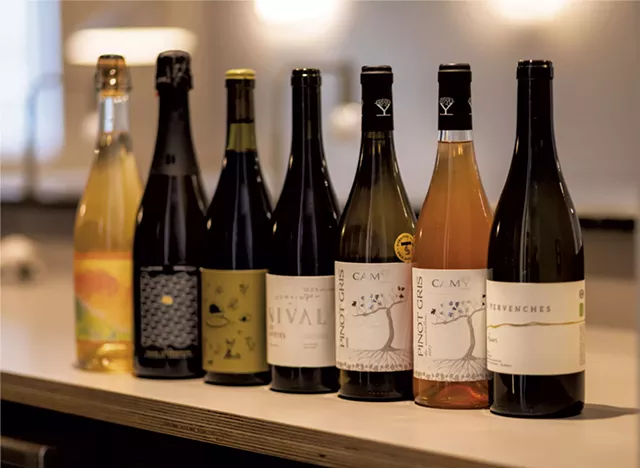When the Michelin Guide debuted in Québec earlier this year, a global culinati zeroed in on the one- and two-star reviews that can vault a locally beloved restaurant to far broader acclaim. The province made a respectable showing. Nine eateries earned the accolades, which, even as skeptics shrug and dining culture evolves, have maintained their decades-long status as the last word in gourmet street cred.
Yet I was drawn to a shorter Michelin list, one announced at the same time but with far less fanfare. Three Québec restaurants landed a Green Star, a distinction introduced in 2020 to honor excellence in eco-friendly cuisine. Reading about Espace Old Mill, Auberge Saint-Mathieu and Restaurant Alentours, I saw that all offered seasonally driven menus highlighting superlocal ingredients. They looked fabulous, but I was curious. As in Vermont, many Québec chefs are playing with locavore menus. What set the chosen restaurants above their peers?
In search of clarity, I emailed, via a media representative, the anonymous chief inspector of the Michelin Guide North America, who flagged the restaurants’ strong focus on Québécois terroir. “These restaurants are at the forefront of practices committed to a more sustainable gastronomy,” the inspector added, sounding curiously bland for a full-time gourmand. (Maybe it’s the soporific effect of all those tasting menus and wine pairings.)
The chefs who earned the Green Stars seemed as eager as me to parse their selection. “They might have private criteria that they’re comfortable with, but I don’t know what those are,” said Tim Moroney, chef and co-owner of Restaurant Alentours, which sources nearly all ingredients within 150 kilometers (about 90 miles) of its Québec City home.
Keen to shed some light on the Michelin mystery, I plotted a summer road trip to visit all three Green Star winners. Conveniently for Vermonters, they arc northeast from a point just past our northern border. The culinary constellation spans an Eastern Townships on-farm restaurant; a chic lakeside inn wrapped in dense Mauricie forest; and a teensy, 10-seat eatery on an unassuming Québec City back street. Taken together, I hoped they’d help me understand any particularly Québécois approach to eco-friendly dining — perhaps an instructive one, too, as the province shares Vermont’s fleeting growing season and roller-coaster weather.
After three gorgeous meals, each completely different yet rooted in profoundly local eating, I’m not sure I grasp Michelin’s Green Star criteria any better than when I started. Yet I certainly ate very well: The dinners ranged from exquisitely simple farm-to-plate to intricate tasting menus foregrounding playful experimentation.
Their sourcing was, unsurprisingly, impeccable. But I also found kitchens wrestling with the broader meaning of sustainability in a changing industry landscape — and meeting the moment with innovations that encompass far more than local ingredients.
Espace Old Mill
7 chemin Caleb Tree, Stanbridge Est, 450-248-2888, espaceoldmill.com
Go for: On-farm, veg-led fare within day-tripping distance of Burlington
As one might expect, farming comes first at this combo country inn and restaurant founded by market gardening advocate Jean-Martin Fortier in a bucolic Eastern Townships village. Greeting us and other arriving guests, the host poured complimentary flutes of bubbly from nearby winery Domaine Bergeville, then invited us to explore the on-site vegetable beds and greenhouse, where vegetables twined upward in uncommonly tidy rows.
“What we do is about translating an idea of human-scale, organic agriculture into a dining experience,” sommelier Alexandre Legault explained once we settled in the low-ceilinged, heavy-beamed dining room overlooking the farm. Otherwise bare wooden tables were set with bouquets of farm-grown zinnias and dill blossoms.
Even in early June, when the harvest glut was still weeks away, the restaurant’s ever-changing five-course tasting menu (CA$90 per person, wine pairing CA$65) led with produce. An appetizer of crunchy kohlrabi, cooked gently in oil infused with fig leaves plucked just outside, had an aromatic garnish of lemon balm and lemon verbena. The combo bridged lingering memories of winter with a promise of brighter flavors to come.
Next came sliced celtuce — a kind of lettuce with a bulblike stem — poached in green pea water, alongside silken sweet peas in pea cream with chervil. A reverent meditation on pea-ness, it recalled the California-led locavore cuisine pioneered by Berkeley’s Chez Panisse that turned the spotlight on once-humble ingredients. Both the kohlrabi and celtuce were sublime in their simplicity, as was a mid-meal serving of spelt bread with whipped butter and garlic-chive powder.
On the night we dined, the menu was effortlessly vegetarian until we reached the main: tender chicken from a nearby producer served alongside shaved purple daikon. Perhaps it’s a tribute to the kitchen’s skill with veggies that the dish, ostensibly a star of the show, was the only one where simplicity teetered on the verge of unexciting.
Dinner regained its footing with a pair of desserts balancing sweet and vegetal. First came a “cake” of dehydrated carrots with a lush dollop of Jersey cream, restrained enough to let the veggies’ natural sugars shine. The meal concluded with a delicately floral chrysanthemum sorbet in fennel cream studded with chamomile blossoms. Both were a triumph.
Retiring from our table to Moroccan-style couches in a nearby lounge, we ordered pots of tea (CA$5) brewed with blends from Sutton herbalist Officinalis. Pulling my palate from farm to forest, a boreal blend of balsam fir, wild roses and juniper berries offered a final taste of Québec before we headed upstairs to bed.
Auberge Saint-Mathieu
2081 chemin Principale, Saint-Mathieu-du-Parc, 819-532-3397, auberge-st-mathieu-du-lac.com
Go for: Stylish, refined tasting menus riffing on seasons with international influence
For guests in his Scandi-chic dining room, where picture windows frame views of tree-lined Bellemare Lake, Trois-Rivières-born chef Samy Benabed crafts eight-course tasting menus (CA$125, wine pairing from CA$90) of what he calls “cuisine of the current moment.”
Where Espace Old Mill proffers guileless simplicity, Benabed serves more cunning fare drawing on his background as a country-hopping, fine-dining stagiaire. (These unpaid internships included a stint at Copenhagen’s influential Relæ.)
Take the “lobster roll,” a slim cigar of North African phyllo-style pastry encasing sweet lobster meat from the Gaspé Peninsula, emulsified lobster shell oil and garlic sour cream. Benabed, whose parents are from Morocco, explained that he sees the dish as capturing not only the brief Gaspésie lobster season but also the nostalgic rush of the oncoming summer. (The pastry wasn’t the only Maghreb-inspired flourish: A bite-size whitefish roe appetizer came atop a crisp round of the Moroccan fritters called sfenj.)
Other dishes leaned into sheer sensorial thrill. Turmeric milk foam turned a tidy square of arctic char indulgently lush, with a scattering of trout eggs and brown butter breadcrumbs lending a salty frisson.
Produce sourced from a handful of nearby farms — used in dishes such as a turnip “dumpling” hollowed out and stuffed with pork — remains the heart of the menu. That approach extends through the winter with fermentation, pickling and preserving. A line of jarred house preserves glints in the dimly lit entryway.
Yet Benabed’s approach eschews some locavore pieties: He brings spices home from Morocco, and the wine list roves from Lebanon to the Loire Valley. When I asked about sustainability, Benabed first nodded to his exacting sourcing, then took the word in a different direction.
“Is sustainability how you supply? Yes, obviously — but you also have a more human side,” he said. Over his career, Benabed said he saw too many workers burned out by the intensity of kitchen culture. He was determined to do better at the restaurant he opened in 2022. Tips at Auberge Saint-Mathieu are shared across the staff, the pace is slower, and no one works more than 40 hours a week — an extraordinary feat in the world of fine dining.
“If you want to be sustainable in the long term, it has to be sustainable for the people you work with,” Benabed said.
Restaurant Alentours
715 rue Saint-Bernard, Québec City, -581-985-2050, restaurantalentours.com
Go for: Boundary-pushing local sourcing and delightfully personal chef time
Well outside the cobblestoned core of Québec’s Old City, this teensy neighborhood restaurant seems to pose a playful question with every aspect of its seven- to nine-course, shared-plate tasting menus (CA$110): What if?
The kitchen uses no fossil fuels. Chef Tim Moroney cooks on an induction stove powered by hydroelectricity. Moroney, who is originally from New York and owns the restaurant with his Québécois wife, Frédérique Hamel, sources everything but salt, milk and beef within a 150-kilometer radius of Québec City. At nearly 47 degrees north, that qualifies as a bold experiment in local eating, but Moroney says it’s primarily a way to celebrate the flavors of his adopted home with granular focus.
“It’s more about community and transparency than borders, specifically,” Moroney said. “Local food sourcing is one of the most specifically beautiful aspects of where we are.”
Alentours, whose name translates to “surroundings,” makes ample use of preservation to extend the growing season. By early June, the first fresh veggies were trickling in from area farms: A plate of grass-green asparagus under sunny turmeric hollandaise got its crunch from dried yellow peas fried to a crisp.
The drinks list (by-the-glass wine CA$14-16) stretches to a 250-kilometer radius, to permit vintages made in Eastern Townships vineyards. My boysenberry-hued Liqueur des Vignes cocktail (CA$22) blended Québécois rye, red wine, puréed black currants and birch syrup.
Moroney is also dedicated to reducing waste through creative reuse. On the evening I visited the sleek, modern dining room, herb stems became pesto for tender cavatelli pasta. Potato skins infused into ice cream lent malty sweetness that paired well with crumbly rosemary cookies.
Those playful riffs on otherwise compost-bound foods aren’t Moroney’s only experiment. After Moroney and Hamel welcomed a son last December, the couple decided to lay off their small staff and shrink the operation to a scale they hoped would balance more easily with a young family’s needs.
Today, meals are served at the 10-seat bar just Thursday, Friday and Saturday, and Moroney shuttles between front and back of house while playing chef, server and bartender. (Bookings open at noon on the first day of the prior month, and reservations fill swiftly.) It’s an impressive undertaking, and if pauses between courses occasionally tipped from leisurely into protracted, Moroney’s effervescent, chatty presence more than compensated.
“Restaurants are run by humans,” Moroney told me later, noting, like Benabed, that he saw this as perhaps the most challenging aspect of making a dining room sustainable.
“Right now, it is a family restaurant — family-owned, family-run,” Moroney said. “Right now, in our lives, it works best at this extremely small scale.”
Where to Sleep It Off
Postprandial overnights, from farm stays to urban eco hotels
Diners at Espace Old Mill can just amble upstairs to its five-room inn, La Cecil House (from CA$185). Accommodations are bright and simple and include access to a shared kitchenette furnished with self-serve coffee and tea. (The upstairs rooms can be quite loud while dinner service lasts, so diners who tend to retire early might wish to bring earplugs or sleep elsewhere.) While Burlington is just one hour and 10 minutes away, it’s well worth the stay in pretty Stanbridge East, a village with nicely preserved, British-inflected Loyalist architecture; the small Missisquoi Museum; and a couple of cute antique shops. In the morning, stroll across the Pike River for breakfast sandwiches or pastries at Café Blinn.
At three and a half hours north of Burlington, a trip to Auberge Saint-Mathieu means at least one overnight — more if you’re planning to visit the nearby La Mauricie National Park. The on-site, 10-room inn (from CA$175) is lovely but often fully booked on weekends. Instead, I spent the night 13 miles away, at Le Baluchon Eco Resort (from CA$263), a sprawling property with a restaurant, thermal spa, and 22 miles of trails for hiking, mountain biking and cross-country skiing. Options range from lodge-like rooms to entire cottages and glass-walled cabins. Rates include breakfast, trail access and some recreational equipment.
Visiting Restaurant Alentours, at the edge of Québec City’s Saint-Sauveur neighborhood, is a great excuse to explore stylish shops and bars along its thoroughfare, rue Saint-Vallier Ouest, which is far less touristy than the cobblestoned Old City. (The street is currently undergoing major construction but is largely accessible to pedestrians.) For an overnight, though, it’s nice to stay at the heart of the action. On a backstreet near the Québec citadel is Hôtel Nomad (from CA$109), whose sustainability strides — from energy reduction to elimination of in-room, single-use plastic — made it the city’s first hotel to earn a Biosphere Sustainable Lifestyle Certification.

